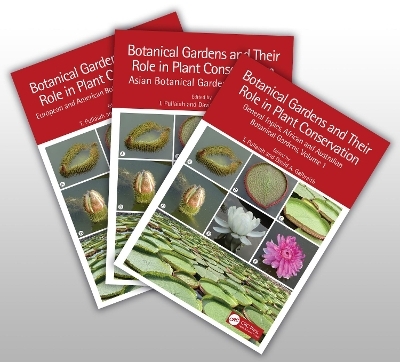
Botanical Gardens and Plant Conservation
CRC Press
978-1-032-25214-8 (ISBN)
Approaching the contributions of a world-wide sector of scientific institutions to addressing the extinction crisis, Botanical Gardens and their Role in Plant Conservation brings together a diversity of perspectives. There are over 3,600 botanical gardens world-wide, where trees, shrubs, herbs, and other plants are studied and managed in collections. They are foremost among efforts to conserve the diversity of living plant species and ensure that crucial biodiversity is available for the future of humanity.
This book is a showcase for plant conservation, restoration, biodiversity, and related scientific and educational work of botanical gardens around the world, featuring both thematic overview chapters and numerous case studies that illustrate the critical role these institutions play in fighting extinction and ensuring plant diversity is available for sustainable use.
Features:
A wide range of case studies derived from practical experience in a diversity of institutional, national, and biogeographical settings
Reviews of topics such as networking amongst institutions, the importance of global policy agreements such as the Convention on Biological Diversity and the Global Strategy for Plant Conservation
Profiles of botanical gardens contributions at the national level to conservation priorities
Real-world examples of programs in plant conservation for both critically endangered wild plant diversity and unique horticultural or cultural germplasm
Botanical Gardens and their Role in Plant Conservation includes contributions from institutions from Africa, Asia, Australia, Europe, and the Americas, and institutions of all sizes and histories, from long-established national gardens to new gardens offering their perspectives on developing their roles in this vital undertaking.
Prof. T. Pullaiah obtained his M. Sc. and Ph. D. degrees in Botany from Andhra University. He was a Post-doctoral Fellow at Moscow State University, Russia, during 1976-1978. He travelled widely in Europe and visited Universities and Botanic Gardens in about 17 countries. He joined Sri Krishnadevaraya University as Lecturer in1979 and became Professor 1993. He has published 120 books, 345 research papers and 35 popular articles. His books have been published by reputed International publishers like Elsevier, Springer, CRC Press, Taylor & Francis, Apple Academic Press, Scientific Publishers, Astral International, CBS Publishers etc. Under his guidance, 54 students obtained their Ph. D. degrees and 34 students their M. Phil. Degrees. He is the recipient of P. Maheshwari Gold Medal, Prof. P.C.Trivedi medal for Editorial excellence and Dr. G.Panigrahi Memorial Award of Indian Botanical Society and Prof. Y. D. Tiagi Gold Medal of the Indian Association for Angiosperm Taxonomy. He was President of Indian Association for Angiosperm Taxonomy (2013) and President of the Indian Botanical Society (2014). He was a member of Species Survival Commission of International Union for Conservation of Nature and Natural Resources (IUCN). David Galbraith completing his B.Sc. and M.Sc. at University of Guelph and Ph.D. at Queen’s University at Kingston, in Canada. His early research focused on evolutionary ecology of aquatic vertebrates. Following a post-doctoral fellowship in Canterbury, England, he served as executive director and curator of a small AZA-accredited center for endangered wildlife species conservation. In 1995 he joined Royal Botanical Gardens (Canada) to develop biodiversity projects among botanical gardens across Canada in response to the Convention on Biological Diversity. In 2006 he was appointed RBG’s Head of Science, overseeing library, archives, and herbarium, research, and use of RBG resources by outside researchers. He has published many contributions on conservation policy, management, and history of botanical gardens. In 2002 Dr. Galbraith was honored by the American Public Gardens Association with their annual Professional Citation for his innovative work in public horticulture. He was named Hamilton Environmentalist of the Year in 2010 for his efforts to protect nature. Dr. Galbraith has always been passionately engaged in biology, history, cultural heritage, and the arts, and is fascinated by how all of these intersect within botanical gardens. He is an adjunct biology professor at McMaster University, a Fellow of the Royal Canadian Geographical Society, and a Fellow International of the Explorers Club.
Volume 1
Chapter 1. The Role of Botanical Gardens in Plant Conservation: An Introduction
Chapter 2. Creating Communities of Practice for Plant Conservation, and Catalyzing Action
Chapter 3. Botanic Gardens Contribute to Food Security Through Education, Conservation, and Research
Chapter 4. A global network of seed banks conserving wild plant species and supporting agriculture, forestry, livelihoods, and restoration
Chapter 5. Botanic Gardens and the Access and Benefit Sharing Regime -China
Chapter 6. The Role of Botanical Garden in Education and Plant Conservation toward the new Biodiversity and Plant Conservation Strategy
Chapter 7. Conservation Through Propagation and Dissemination
Chapter 8. The Role of Botanical Gardens in Plant Diversity Conservation of Sierra Leone
Chapter 9. Botanical Gardens in Tanzania and Their Role in Plant Conservation
Chapter 10. The Role of Egyptian Botanical Gardens in Germplasm Conservation - EL-Saady Badawy and Wafaa M. Amer
Chapter 11. Botanical gardens in Ghana and their role in Plant conservation
Chapter 12. Plant rescue, Care and Restoration after Bushfire: a few recent examples from Australia
Chapter 13. Evolving to address the State of the Environment - Botanic Gardens and State Herbarium, South Australia
Volume 2
Chapter 1. Botanical Gardens and Plant Conservation Initiatives in Nepal
Chapter 2. Role of Indonesian Botanic Gardens in Plant Conservation
Chapter 3. Vietnam Botanic Gardens and Their Role in Plant Conservation
Chapter 4. Botanical Gardens in Malaysia and their role in plant conservation
Chapter 5. Ancillary Botanic Gardens: A case study of the American University of Beirut
Chapter 6. Conservation of Threatened Plant Species and Protected Areas in Korean Botanical Gardens and Arboreta
Chapter 7. Mongolian Botanical Gardens - Modern plant biodiversity conservation resources in Mongolia
Chapter 8. Jawaharlal Nehru Tropical Botanic Garden and Research Institute, a treasure house of tropical plant germplasm, blends into the Western Ghats, the biodiversity hotspot in Indian Region
Chapter 9. Botanical Gardens and their role in education, research, conservation and bio-prospecting of plant diversity: Lead Botanical Garden (LBG), Shivaji University, Kolhapur- a case study -
Chapter 10. Lead Botanic Garden of Yogi Vemana University, Kadapa, India and its role in plant conservation
Chapter 11. Dhanikhari Experimental Garden-cum Arboretum
Chapter 12. M. S. Swaminathan Botanical Garden - A Community Conservation Initiative in the Western Ghats of India
Chapter 13. Calicut University Botanical Garden (CUBG) and its role in Plant conservation
Chapter 14. Role of Botanical Garden in Conservation and Citizen Science – A case study from Mahatma Gandhi Botanical Garden, University of Agricultural Sciences, Bangalore
Chapter 15. The Role of the Kuzbass Botanical Garden in Solving Environmental Problems and in Plant Conservation In Situ and Ex Situ
Chapter 16. Contribution of botanic gardens to plant conservation: 233 years of conservation history and actions of CSIR-NBRI botanic garden
Volume 3
Chapter 1. The Role of Botanic Gardens and Arboreta in Plant Conservation in Serbia
Chapter 2. Botanical Gardens in Slovakia and their role in plant protection
Chapter 3. The Botanical Garden of the National Museum of Bosnia and Herzegovina
Chapter 4. The Role of Russian Botanical Gardens in Plant Biodiversity Conservation
Chapter 5. Illustrating the roles of botanical gardens in plant conservation: The Muséum national d’histoire naturelle: contribution to the Global Strategy for Plant Conservation
Chapter 6. Botanical Gardens and their Role in Plant Conservation in Greece
Chapter 7. Plant conservation programs of the Balkan Botanic Garden of Kroussia and the Greek Gene Bank
Chapter 8. Role of Atlanta Botanical Garden in Plant conservation
Chapter 9. The Center for Plant Conservation – a Network of Botanical Gardens in USA and its role in Plant conservation
Chapter 10. Plant conservation efforts at the San Diego Botanic Garden
Chapter 11. Plant Conservation at Houston Botanic Garden
Chapter 12. Plant Conservation at the University of California Botanical Garden at Berkeley
Chapter 13. Royal Botanical Gardens (Canada): Conservation of Plants and Nature by an Urban Botanical Garden
Chapter 14. The Contribution of the Montreal Botanical Garden to Plant Conservation
Chapter 15. A botanical garden dedicated to the conservation of plants in the dry inter-Andean valleys of Bolivia
Chapter 16. Conservation efforts for a threatened endemic palm of Bolivia: The Role of Botanical Gardens
| Erscheint lt. Verlag | 31.10.2023 |
|---|---|
| Zusatzinfo | 37 Tables, black and white; 271 Illustrations, color; 9 Illustrations, black and white |
| Verlagsort | London |
| Sprache | englisch |
| Maße | 178 x 254 mm |
| Gewicht | 1664 g |
| Themenwelt | Medizin / Pharmazie ► Medizinische Fachgebiete ► Pharmakologie / Pharmakotherapie |
| Naturwissenschaften ► Biologie ► Botanik | |
| Weitere Fachgebiete ► Land- / Forstwirtschaft / Fischerei | |
| ISBN-10 | 1-032-25214-6 / 1032252146 |
| ISBN-13 | 978-1-032-25214-8 / 9781032252148 |
| Zustand | Neuware |
| Informationen gemäß Produktsicherheitsverordnung (GPSR) | |
| Haben Sie eine Frage zum Produkt? |
aus dem Bereich


